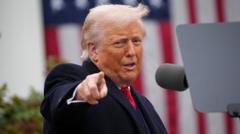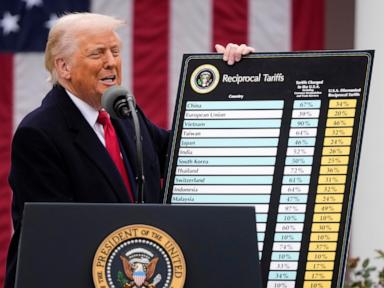President Trump took his biggest gamble yet on the economy Wednesday when he pressed forward with sweeping tariffs on imports from nearly every country in the world.
But in fulfilling a key campaign promise, he also ignored warnings that targeting key trading partners – from the likes of China, Japan and the European Union – will raise prices at home and risk the eruption of a global trade war.
The tariffs also stand to inject a fresh round of uncertainty in the stock market and a slew of industries, from auto parts to steel and groceries, leaving Americans bracing for higher prices and some economists concerned about the risk of a recession.
Other financial analysts also suggested Wednesday that Trump’s three major goals in imposing the tariffs – bringing more manufacturing to the U.S., increasing U.S. revenue, and negotiating lower tariffs with foreign countries – could all potentially work against each other.
While Trump doubled down on his plan for reciprocal tariffs, the stock market experienced major sinks over the last several weeks.
Despite the rattled markets, the president expressed confidence that tariffs are the route to making America wealthy again, which he has pitched since his time on the campaign trail as part of his “America first” agenda.
“We truly can be very wealthy, we can be even wealthier than any other country. It’s not even believable,” Trump said from the Rose Garden on Wednesday. “We take care of countries all over the world… we have to take care of our people and we’re going to take care of our people first.”
Trump imposed a 10 percent tariff that will go into effect on Friday on a plethora of countries but outside of those, about 60 countries will face a higher reciprocal tariff, which will go into effect on April 9 at 12:01 a.m. The president also announced a 25 percent tariff on all foreign-made automobiles that will take effect at 12:01 a.m. April 3.
The president also targeted some of the U.S.’s closest trading partners, including Canada for its tariffs on dairy products imported to the U.S., the European Union for its ban on most American poultry, Australia for its ban on American beef, and the 700 percent tariff on rice from Japan.
“In many cases, the friend is worse than the foe in terms of trade,” Trump said.
The business community, lawmakers and economics quickly hit back on the president’s announcement.
Among other high tariffs imposed were 20 percent on the European Union, 46 percent on Vietnam, 32 percent on Taiwan, 24 percent on Japan, 26 percent on India, 21 percent on Switzerland, 32 percent on Indonesia, 24 percent on Malaysia, 49 percent on Cambodia and 10 percent on the United Kingdom.
Trump appeared to punish China the worst by imposing a total 34 percent tariff that White House officials said would be on top of a previously implemented 20 percent for a total 54 percent tariff on goods.
The exact formula used to determine the tariffs was not immediately clear. Officials said they took tariffs on U.S. goods, plus non-trade barriers like currency manipulation, and cut it in half to get the final tariff.
The U.S. Chamber of Commerce, the top pro-business lobbying group, opposed the announcement, urging the administration to instead focus on tax policy and deregulation.
“What we have heard from businesses of all sizes, across all industries, from around the country is that these broad tariffs are a tax increase that will raise prices for American consumers and hurt the economy,” Neil Bradley, the Chamber’s ...













